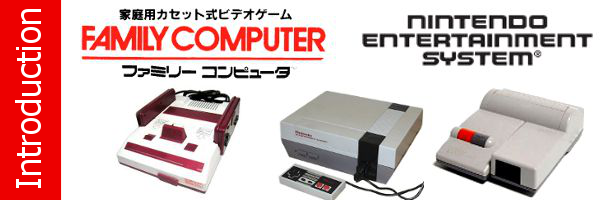
The Nintendo Entertainment System is an icon of the 1980s. It’s the console which introduced video gaming to millions of people across the world. As we kids of the 1980s grow older, it’s our nostalgia for the NES and other consoles which drives us to begin collecting video games.
For those of you who are just starting out collecting games, or missed the NES the first time around, this feature will tell you everything you need to know about the NES.
Key Facts
- First released in Japan on July 15, 1983 as the Nintendo Family Computer
- Limited release in North America on October 15, 1985, then nationwide in 1986
- Released in continental Europe (PAL B) on September 1, 1986.
- Released in United Kingdom, Italy and Australia (PAL A) in 1987.
- #1 selling game: Super Mario Bros (1985) with 40 million units
- #1 selling non-bundled game: Super Mario Bros. 3 (1988) with 18 million units
- 61.9 million consoles sold worldwide
- Officially discontinued in 2003
|
--
Significance
The NES breathed new life into the home video game market. In Japan, it was a powerful yet affordable alternative in an expensive market. In America, it brought video games back to the mainstream after the great market crash in 1983. In Europe and Australia, it introduced a legitimate competitor to computer games, which had become popular when affordable computers like the ZX Spectrum and Commodore 64 hit the market.
Many of Nintendo’s early NES titles were ports of their arcade hits like Donkey Kong, Donkey Kong Junior and Popeye. They transitioned out of making arcade games and turned their full focus to the NES. The result was the beginnings of some of the biggest video game series. A number of Nintendo’s most famous game series made their debut on the NES – Super Mario Bros., The Legend of Zelda and Metroid to name a few. Even some of Nintendo’s series that wouldn’t be released in English until years later made their debuts on the Famicom – Fire Emblem, Mother/Earthbound and Famicom Wars.
The Famicom’s success in Japan ushered in the beginning of the golden age of Japanese game development. Many developers and publishers rose to prominence in this era – Konami with Contra, Metal Gear, Gradius and Castlevania, Capcom with Mega Man and many Disney licensed titles, Hudson with Adventure Island and Bomberman, Enix with Dragon Quest and Squaresoft with Final Fantasy, just to name a few. A number of games that had success on computers or in arcades became smash hits on the Famicom and NES.
Third party development also took off in the West, with Acclaim Entertainment leading the charge as publisher. Rare, who had much experience developing games for the ZX Spectrum, became a developer of choice for the NES after being one of the first western developers to get a development license from Nintendo. While their early output is largely bad licensed games, they would later become fan favourites with RC Pro-Am, Snake Rattle ‘n’ Roll and Battletoads.
Did You Know?
- The NES was not Nintendo’s first home game console – the Color TV Game series preceded it.
- Design on the machine was done by Nintendo R&D2 led by Masayuki Uemura
- The Famicom project dates back to 1980
- The NES was first introduced to North America as the Nintendo Advanced Video System (AVS) at CES 1984 to a disinterested crowd
- Nintendo tried to broker a deal with Atari to distribute the system in America
- Mattel handled marketing and distribution of the NES in the UK, Italy and Australia until as late as 1994
- Some early NES games are Famicom games with a 60 to 72 pin converter inside.
- The final official release was Wario’s Woods. It is the only NES game to carry an ESRB rating in North America.
- Many NES and Famicom games were re-released for the Game Boy Advance in 2003 as part of celebrations for the console’s 20th anniversary.
|
--
Market Success
Nintendo enjoyed complete market dominance with the Famicom in Japan and the NES in America – holding a marketshare of as much as 90%. The company made the most of their market domination, strong arming third party developers into exclusivity contracts and monopolising the manufacturing and supply of cartridges. This treatment of licensees would come back to bite Nintendo, first in the form of a government intervention (which led to them offering US owners $5 off coupons) and later when third parties began to strike deals with Sony in the PlayStation era.
Europe and Australia were different to the rest of the world. Nintendo faced stiff competition from a well established computer gaming scene and the Sega Master System. The NES was late to the party due to Nintendo’s fractured European distribution plans (Nintendo International handled continental Europe, while Mattel handled UK (until 1990), Italy (until 1991), Australia and New Zealand (until 1994)). Price was the major issue – a NES game could cost as much as £75/$99.95, whereas Master System games rarely topped £30/$59.95, and computer games cost a pittance. It wasn't until Nintendo took control of operations that the NES became a factor in the UK - they dropped the price of the console and introduced the Teenage Mutant Hero Turtles bundle, helping them to sell 1 million units in 1991 alone. Famicon clones became popular low cost options in territories where Nintendo did not officially operate – most notably in Russia, where the popular Dendy clone reigned supreme.
Collecting for the NES
So you’ve decided you want to get some Famicom and/or Nintendo Entertainment System stuff – good for you! You’re in for a lot of fun. Before you begin, you need to know what you’re in for, so we've assembled this list of the advantages and disadvantages of collecting for the NES and Famicom.
| Advantages |
Drawbacks |
- The NES has a large library of games (800+ English releases) with plenty of variety like platformers, sports games, beat ‘em ups and arcade ports.
- Many classics such as Super Mario Bros., The Legend of Zelda, Metroid, Final Fantasy, Mega Man and Castlevania debuted on the system. Age has done little to dim their charm
- The games and system are easy to get a hold of. The best games were produced in large numbers.
- Very cheap to collect for if you just want the games, especially if you buy in bulk lots
|
- Tons of really bad games. Almost anything licensed is guaranteed to be terrible
- Hardware reliability – the NES has issues with the security chip or the cartridge connector, resulting in a blinking grey screen. The Famicom Disk System suffers from a weak disk drive cable. Wired pads on the Famicom are also annoying
- Many of the peripherals are of poor quality. The Power Glove, ROB and U-Force look cool, but they don’t work as intended
- Games were packaged in cardboard boxes. Boxes were either thrown out or worn out over time. Collecting complete-in-box games is an expensive exercise. Ditto for the original boxes for consoles/accesories.
|
--
The Games
There are a ton of games for the NES, so we've assembled these guides to give you a few leads on which games you need to try out.
The Essential Nintendo Entertainment System (NES) Games
The Underrated NES Games (coming soon)
The Most Expensive NES Games (coming soon)
Collecting for the NES on a budget (coming soon)
The Best Imports on the NES (coming soon)
We also made this handy visual table to show you the different types of game media used on the system.
 |
Famicom cartridges
Japanese games are smaller, have 60 pin connectors and the cartridges come in a variety of colours. Most will argue that the box art is better.
|
 |
Famicom Disks
Japanese games which come on small magnetic diskettes, not unlike the old 3.5 inch floppies used in PCs until the early 2000s. They’re yellow and come in small packets. Some of these games were re-released as cartridges when Nintendo stopped focusing on the FDS. |
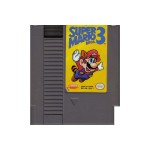 |
NES cartridges
These are larger 72-pin cartridges intended for the US, PAL-A and PAL-B markets. The vast majority of these carts are grey. The majority of games were packaged in a cardboard box with a black protective sleeve, instruction book and a small Styrofoam brick – some games also had promotional materials inside. Early Asian and European (PAL-B) first party games (distributed by Nintendo International) came in smaller boxes with different art – these are in very high demand. |
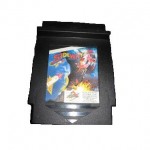 |
Piggyback carts
Piggyback carts are usually unlicensed games which require a standard licensed NES game to be plugged into the top in order to fool the NES’s security chip into thinking it is a normal game. |
--
Why would anyone want Japanese stuff?
Aside from the obvious aesthetically pleasing box art, some Famicom games have advantages over their Western equivalents. Nintendo of America was notoriously strict with censorship, whereas Nintendo Co. Ltd was not – so Japanese games usually have more gore and adult content that was toned down in their Western versions.
Additionally, The Famicom had two cartridge pins which allowed cartridges to provide external sound support – this feature was cut from the NES. For example, Konami and Sunsoft employed sound chips for better music in their games. This video highlights the difference in sound quality between Castlevania III: Dracula’s Curse, and the Japanese release Akumajou Densetsu. |
--
Hardware
There were many variations of the Famicom and NES produced - more than just the common three. Everything from arcade hardware to hotel jukebox style units was sent out into the wild.
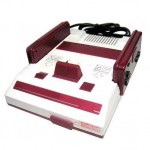 |
Family Computer (1983)
The earliest versions have a fault which causes them to die, but few of these systems should be out there since Nintendo recalled them many years ago. Early versions have hardwired controllers, with a microphone on the second pad – later versions used detachable controllers. It only supports RF output. |
 |
Famicom Disk System (1986)
This expansion allowed for the use of double sided, rewritable magnetic, boosting the size of games and adding the ability to save data along with limited FM synthesis support. Players could also purchase blank disks and buy games from Nintendo kiosks. Introduced the mascot Disk-kun to the world. FDS releases were phased out as piracy on the format became rampant. The belts on the disk drive tend to break quite easily and are difficult to replace due to their proprietary size (and the fact Nintendo stopped repairing them in 2003), and the disks can de-magnetise. |
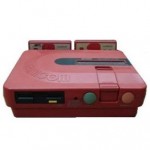 |
Famicom Twin (1986)
Sharp was heavily involved in the design of the Famicom, and licensed the rights from Nintendo to produce their own version of the system. The FC Twin encompasses both the Famicom and the Disk System in one unit. It’s a jazzy looking thing, but it’ll set you back a pretty penny. It’s the first version of the Famicom to support composite output. It’s also available in a number of different colour configurations. |
 |
AV Famicom (1993)
Nintendo issued a budget priced re-design of the Famicom in 1993 which was sleeker and added support for composite video output, eliminating the standard RF port from the console. It uses the same Multi AV connector as the Super Famicom, SNES, Nintendo 64 and GameCube. |
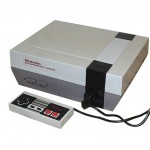 |
Nintendo Entertainment System (1985)
The front-loading style NES is the most common model you’ll run into. It was first released in 1985 in limited North American markets before a nationwide, then international release in 1986. This model supports both RF and composite video output. It has two common issues – the zero insertion force module can bend the pins on the cartridge connector, but they can be replaced without too much trouble. The other issue comes from the security chip, which can cause a blinking grey screen – that can be solved by clipping one of the connectors. European versions can be badged as either “Mattel†or “NES†versions, but there is little difference beyond who distributed the units. |
 |
Nintendo Entertainment System (1993)
The top-loading style NES came out in 1993 at a budget price. It solves the issues with the cartridge connector and security chip. It can also play NES games from any region without issue. Unfortunately, the vast majority of units only support RF output. Three versions of the console exist – the standard one, another RF only one with better video output, and a composite version which was issued in limited numbers. The top-loading system was only released in North America and Australia. It commands a premium price compared to the standard system. |
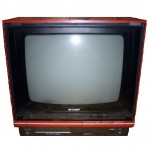 |
C1 Famicom Television/Sharp Nintendo Television
This rare CRT TV features a built in Famicom or NES (depending on your region) which gives it the best possible video quality. It was released in 1983 in Japan and 1989 in North America, and was manufactured by Sharp. These units are very difficult to source. |
 |
M82 Display System
This was an in-store kiosk which Nintendo used to demonstrate new release games. It could support up to 12 games which could be selected like a jukebox. Unlike other systems of this type, the machine took standard NTSC NES cartridges. It also supports a set play time feature. Other Nintendo store demo kits exist, but this is the most common. |
 |
Famicom Box
The Famicom Box is like the M82 display system in that it was designed for store demo use, but uses specific types of cartridges that do not work on standard Famicoms. They do work on an NTSC NES, however. Eleven games were made for the Famicom Box, including Super Mario Bros., Duck Hunt and Ghosts 'n' Goblins. |
 |
PlayChoice 10
A jukebox style arcade system which used custom versions of NES games. 54 games were produced for the PlayChoice-10 – the library is comprised of the most popular NES games. Has an extra CPU which controls a timer display, and most ROMs have an 8KB expansion module used to provide tips to players. There were a number of different Playchoice cabinet styles, ranging from conversion units to deluxe cabinets. |
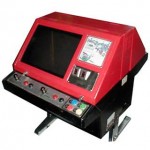 |
Nintendo VS System
Another NES-based arcade system designed for two player competitive player. It was originally designed as a conversion kit for existing Donkey Kong and Donkey Kong Jr. arcade machines. Over 40 games were available for the VS System – many are identical to their NES versions, but some have minor differences. Vs. Super Mario Bros is somewhat harder than the home version, for example. |
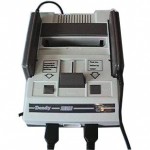 |
Clones
The NES and Famicom used off the shelf hardware in their design, making unlicensed clone systems easy to develop. Clones generally come in two forms – contemporary and modern. Contemporary clones like the Dendy were sold at the same time as the FC/NES, while modern clones like the Generation Nex and FC Twin were released well after the NES’s time. Some companies have also released portable clones. Modern clones tend to use "System on a Chip" designs. |
--
Why are there two PAL formats and what is the difference between them?
The main reason is that Mattel licensed the NES for distribution in the UK, Italy and Australia, while Nintendo controlled distribution for mainland Europe. They decided to make the cartridges incompatible despite them running on the same hardware to prevent grey imports and other malarkey. Generally there is no difference between the two types – early releases hit mainland Europe in smaller boxes, but that’s really it. If you want to play PAL B on your PAL A system or vice versa, you need to disable the lockout chip or use a toploading console. |
--
Bundles
Nintendo sold the NES in a variety of configurations, mainly to provide greater value for money and to lure unsuspecting parents in. The table below contains the major bundle sets you will come across. Many of these were released in multiple territories.
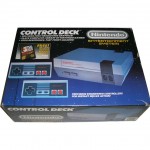 |
Control Deck
- System
- 2x controllers
- Super Mario Bros.
All regions - some later versions had Super Mario Bros. 3 packed in |
 |
Deluxe Set
- System
- 2x controllers
- Zapper
- R.O.B.
- Gyromite
- Duck Hunt
All regions |
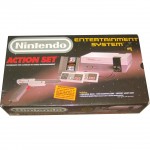 |
Action Set
- System
- 2x controllers
- Zapper
- Super Mario Bros. / Duck Hunt
All regions |
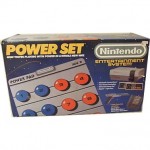 |
Power Set
- System
- 2x controllers
- Power Pad
- Super Mario Bros. / Duck Hunt / World Class Track Meet
North America only |
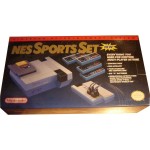 |
Sports Set
- System
- NES Satellite
- 4x controllers
- Super Spike V’Ball / Nintendo World Cup
North America only |
 |
Challenge Set
- System
- 2x controllers
- Super Mario Bros. 3
North America only |
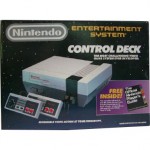 |
Basic Set
- System
- 2x controllers
- Official Nintendo Player’s Guide
Sold outside of North America without the book |
 |
Super Set
- System
- 4x controllers
- Four Score
- Super Mario Bros. / Tetris / Nintendo World Cup
UK/Europe only |
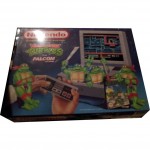 |
Teenage Mutant Hero Turtles Bundle
- System
- 2x controllers
- Teenage Mutant Hero Turtles
UK, France and Germany |
 |
Smurfs Bundle
- System
- 2x controllers
- The Smurfs
France only |
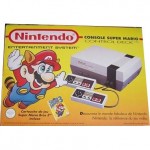 |
Super Mario Bros. 3 bundle
- System
- 2x controllers
- Super Mario Bros. 3
France only |
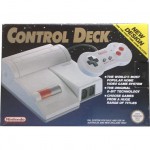 |
NES-101 (Toploader)
North America and Australia |
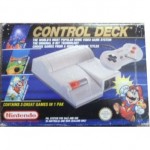 |
NES-101 w/ game
- System
- 1x controller
- Super Mario Bros. / Tetris / Nintendo World Cup
Australia only |
--
Accessories
There are a ton of accessories for the NES and Famicom - we've showcased the major licensed peripherals here, and a few important other ones, but there are far more out there.
 |
Famicom Controller
This is the standard issue FC controller. Most consoles will have hardwired controllers. The second pad has a microphone in place of the start and select buttons, but few games use it. |
 |
Famicom Four Way
Allows four controllers to be used with the Famicom. Mainly supported by the Kunio series. |
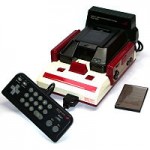 |
Famicom Net System / Famicom Modem
A modem which allowed players to connect to a service that provided hints, jokes, weather forecasts and some minor downloadable content. It could also be used to place share trades. It was not used for multiplayer gaming, however. |
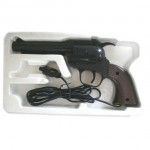 |
Famicom Beam Gun
The Famicom equivalent of the Zapper, it looks more like an Old West style six shooter than the futuristic gun we’re familiar with. No doubt influenced by the old light sensor shooting toys designed by Gunpei Yokoi and sold by Nintendo in the 60s and 70s. |
 |
Datach Joint ROM System
Similar to the Aladdin Deck Enhancer, but with a barcode reader. Supported seven games, all designed by Bandai. |
 |
Famicom 3D System
Like the Master System 3D glasses – an LCD shutter type deal. Seven games were supported. |
 |
Famicom Data Recorder
A device used for saving and sharing programs created in Family BASIC. |
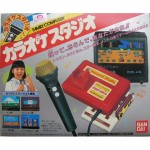 |
Karaoke Studio
A Karaoke System for the FC designed by Bandai. Used its own expansion cartridges for new content. |
 |
Barcode Battler II
Second version of the popular toy interfaced with one FC game – Barcode World. |
 |
NES Controller
Standard issue NES controller. Does exactly what it needs to and stands up to quite a bit of punishment. Not quite so friendly to adult sized hands. |
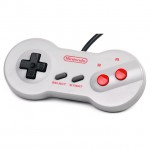 |
Dogbone Controller
Standard issue controller for top-loading systems, but also available separately. It’s a bit more contoured, but still quite small. |
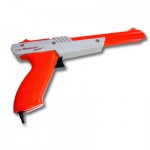 |
Zapper
The NES light gun comes in two colours, grey or orange – the colour was changed to make it seem less gun like after US Federal regulations introduced in 1989 dictated that all toy guns needed to appear colourful so as to not be confused for real guns. |
 |
Aladdin Deck Enhancer
A special cartridge system designed by Codemasters to allow publishers to create their own cartridges at a lower cost. 24 games were planned but only seven were released. |
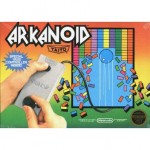 |
Arkanoid Controller
A paddle controller designed to work with Arkanoid games. Came packaged with the game. |
 |
Game Genie
A cartridge which allowed players to modify game data. Players generally use the cart for cheats, but they can be used to access parts of the game that were locked out, like unused code and assets. The Game Genie had a tendency to exacerbate damage to the 72 pin connector. |
 |
Action Replay
Same as the Game Genie, but designed by Datel and mainly sold in Europe and Australia. |
 |
Konami Laser Scope/Gun Sight – A voice-activated head-mounted light gun designed for use with Laser Invasion, but compatible with all Zapper titles. Had troubles with noise cancelling. |
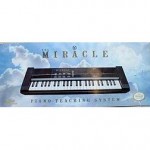 |
Miracle Piano
A cartridge/keyboard combo designed to teach basic piano skills. It’s very difficult to find one complete. |
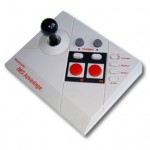 |
NES Advantage
An arcade style joystick manufactured by Nintendo. It also had support for turbo button inputs, making it easy to cheese games like Track & Field. |
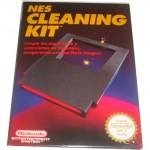 |
NES Cleaning Kit
A kit designed to assist gamers in cleaning their cartridges and the connector inside the system. Better than blowing in your carts, but a mix of rubbing alcohol and water and a set of Q-Tips is just as effective for carts. |
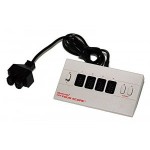 |
NES Four Score
Like the NES Satellite, but wired, making it far more reliable. |
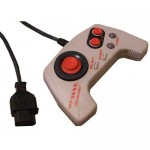 |
NES Max
An analogue style controller that was actually digital. It’s turbo function is better than the NES Advantage, but the pad is otherwise unpopular. |
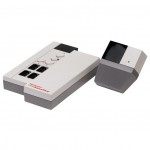 |
NES Satellite
A wireless four player adaptor. Over twenty games support it. |
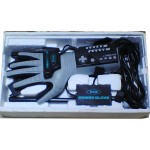 |
Power Glove
Designed to recreate human movements in game, but notoriously bad at doing so. Only two games are supported. |
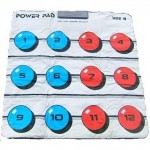 |
Power Pad – Originally designed by Bandai and released with the super rare (in the US) Stadium Events, Nintendo bought the rights to it and re-released the peripheral and game as Nintendo World Class Track Meet. It’s kind of a precursor to the dance mats. Eleven games are supported. |
 |
R.O.B.
The Robotic Operating Buddy was a peripheral designed by Nintendo as part of a ploy to play the NES up as an elaborate toy, so that US toy stores, still recovering from being burnt by the 1983 market crash, would take a punt on their system. Looks cool, but only supports two games and doesn’t work well. |
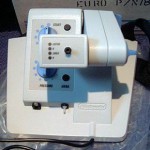 |
Hands Free
A controller designed by Nintendo to allow disabled gamers to play games. The D-Pad is controlled by the tongue, while the A & B buttons were operated by blowing and sipping the straw. It was quite expensive at the time and could only be ordered through Nintendo. |
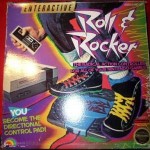 |
Roll n Rocker
A balance board style control system |
 |
U-Force
Broderbund developed infrared controller that interpreted player hand gestures and converted them into in-game actions. Notoriously poor quality. |
 |
Acclaim Wireless Pad
Infrared wireless pads with a rather short range. |
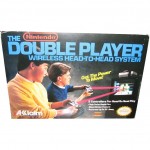 |
Acclaim Double Player
Updated version of the wireless pads that supported two players, rapid fire and a much larger range |
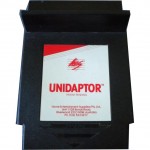 |
HES Unidaptor
Allowed players to use Famicom cartridges on their NES |


































































January 26th, 2012 on 23:24
Superb article!
One small correction, it’s a HES “Unidaptor” and not “Uniadaptor”.